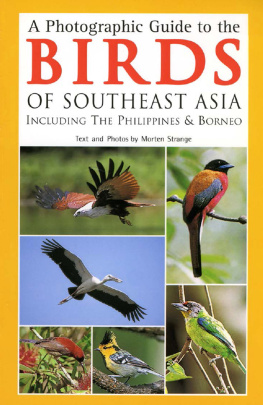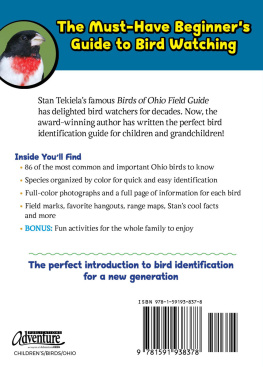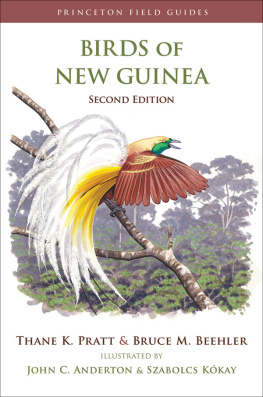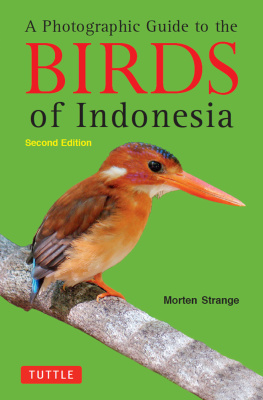Published by Periplus Editions (HK) Ltd.
Copyright 1998 Periplus Editions (HK) Ltd.
ALL RIGHTS RESERVED
Printed in the Republic of Singapore
ISBN: 978-1-4629-1391-6 (ebook)
Publisher: Eric M. Oey
Design: Peter Ivey
Editor: Julia Henderson
Production: Agnes Tan
Cover photographs: Morten Strange
Additional photographs by Lassie Laine,
Pete Morris, Ong Kiem Sian, Atsuo Tsuji,
Eric Woods and Alan Ow Yong
Distributors
Indonesia
PT Wira Mandata Pustaka
(Java Books-Indonesia)
Jalan Kelapa Gading Kirana,
Blok A14 No. 17,
Jakarta 14240
Singapore and Malaysia
Berkeley Books Pte. Ltd.
61 Tai Seng Avenue, #02-12
Singapore 534167
Tel: (65) 6280 1330
Fax: (65) 6280 6290
Email: inquiries@periplus.com.sg
Web site: www.periplus.com
United States
Tuttle Publishing USA
364 Innovation Drive
North Clarendon, VT 05759-9436
Tel 1 (802) 773 8930
Fax 1 (802) 773 6993
Index of Common Names
Adjutant, Lesser 8
Argus, Great 14
Babbler,
Scaly-crowned 50
Sooty-capped 50
Barbet, Blue-eared 40
Red-throated 40
Bee-eater,
Blue-tailed 37
Blue-throated 37
Broadbill,
Long-tailed 42
Bulbul,
Yellow-vented 46
Coucal, Lesser 30
Crake,
Ruddy-breasted 17
Crow, House 48
Large-billed 48
Cuckoo, Indian 29
Plaintive 31
Dove, Spotted 24
Zebra 25
Drongo, Greater
Racket-tailed 47
Egret, Cattle 6
Chinese 6
Great 6
Little 6
Plumed 6
Flowerpecker,
Orange-bellied 62
Yellow-breasted 62
Fruit-Dove, Jambu 22
Greenshank,
Common 20
Heron, Javan Pond 5
Chinese Pond Little 4
Hornbill, Brown 38
Great 38
Oriental Pied 38
Rhinoceros 38
Wreathed 38
Junglefowl, Red 14
Kingfisher, Banded 34
Blue-eared 34
Collared 34
Common 34
Oriental Dwarf 34
White-throated 34
Kite,
Black-shouldered 13
Brahminy 11
Laughingthrush,
Sunda 50
Leafbird,
Blue-winged 45
Greater Green 45
Malkoha,
Chestnut-bellied 28
Mesia,
Silver-eared 50
Myna, Common 58
Hill 58
White-vented 58
Nightjar,
Large-tailed 33
Oriole,
Black-naped 49
Paradise-Flycatcher,
Asian 56
Parakeet,
Long-tailed 27
Parrot, Blue-crowned
Hanging 26
Peacock-Pheasant,
Bronze-tailed 14
Palawan 14
Peafowl, Green 14
Pigeon,
Green Imperial 22
Green-Winged 22
Little Green 22
Pink-necked 22
Thick-billed 22
Pitta, Blue-winged 43
Plover, Malaysian 19
Quail,
Blue-breasted 14
Redshank,
Common 20
Reef-Egret, Pacific 6
Robin, Magpie 52
Sandpiper,
Common 20
Marsh 20
Terek 20
Wood 20
Scops-Owl,
Collared 32
Sea-Eagle,
White-bellied 12
Serpent-Eagle,
Crested 10
Shama,
White-rumped 53
Shrike,
Long-tailed 57
Tiger 57
Starling, Philippine Glossy 58
Stork, Marabou 8
Sunbird,
Brown-throated 60
Crimson 60
Olive-backed 60
Ruby-cheeked 60
Swallow, Pacific 44
Barn 44
Tailorbird, Ashy 55
Tern, Black-naped 18
Little 18
White-winged 18
Thrush,
Chestnut-capped 54
Orange-headed 54
Tit-Babbler,
Striped 50
Tree-Duck, Lesser 9
Trogon, Diard's 36
Turnstone, Ruddy 20
Waterhen,
White-breasted 16
White-eye, Oriental 63
Wood-Partridge, Crested 14
Ferruginous 14
Woodpecker,
Crimson-winged 41

Introduction
Southeast Asia is home to a remarkable array of bird speciesthe most diverse on Earth. These birds range in size from the tiny Orange-bellied Flowerpeckers living deep within the rainforest, to massive White-bellied Sea -Eagles soaring high above the open seas. They vary in color from drab, olive babblers, to exquisitely-hued kingfishers. Lively sandpipers run on the open mudflats, while inert, enigmatic trogons perch motionless just below the rainforest canopy.
Three well-defined, zoogeographical realms lie within Southeast Asia: the Oriental region (extending from Pakistan across southern China, Taiwan, the Philippines and into Indonesia); the Australasian region (reaching from the island of New Guinea, south-east across Australia including New Zealand); and a transitional subregion, known as Wallacea, located between the Oriental and the Australasian regions (covering central Indonesia). Taxonomic research carried out in 1996 by the Oriental Bird Club showed that the Oriental region alone was found to contain a staggering 2,586 bird species. Some are endemic to specific areas or single islands, especially in the Philippines and Indonesia, while others are widespread and found in most countries.
Residents and visitors alike are taking an increasing interest in the birdlife around them, however birdwatching (or "birding") is not that easy in Southeast Asia. Evergreen tropical rainforests are usually the natural vegetation cover and inside these thickly-canopied forests the birds are usually difficult to find and see clearly. These forest birds occupy narrow niches in a complex and static ecosystemthey reproduce slowly and the nests of many have never been found. An alarming number are in danger of extinction. Consequently, national parks and nature reserves have been created throughout the region to protect bird habitats that are, in many cases, disappearing.
The majority of species native to Southeast Asia are unable to adapt to life in villages and gardensthose that do adjust are mostly coastal mangrove residents. A mature garden can be visited by up to fifty of these species during a year and more can be attracted if the right vegetation or a feeding table with fruits and meal worms is provided. The birds we have selected for this Nature Guide are mainly the easy-to-find species that have adapted to living in disturbed habitats near human habitation. These familiar birds are interspersed with some of the more specialized individuals found only in forest habitats. All are presented in conventional taxonomic order.
It is our hope that this introductory guide will help you enjoy the birdlife found in your everyday surroundings and in Southeast Asia's many excellent nature reserves.
Morten Strange
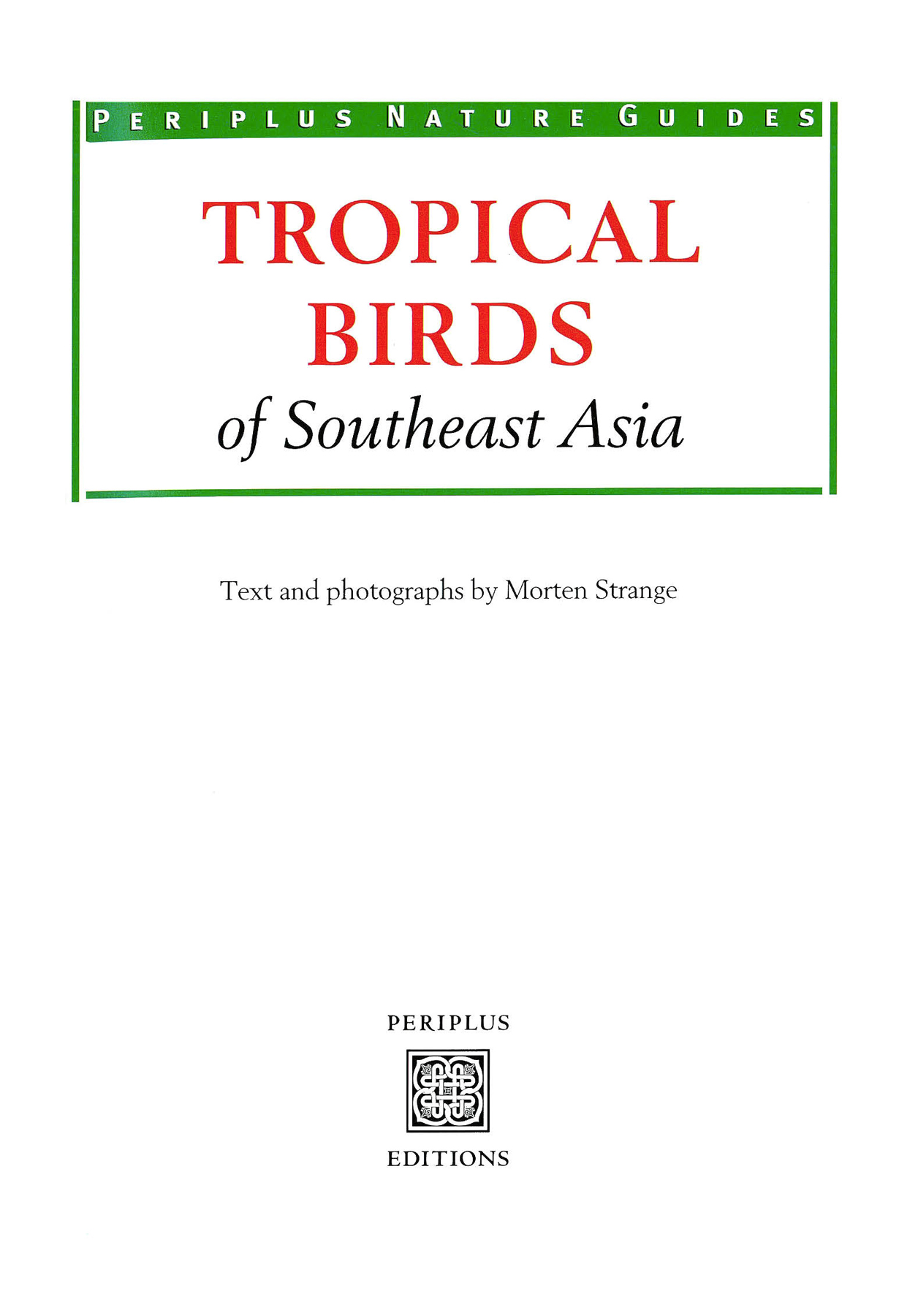
Little Heron
Butorides striatus
The most widespread and common member of the Ardeidae family, the Little Heron is resident throughout Southeast Asia. Like all other family members, it has long legs and a strong beak used for catching fish and other aquatic prey. This heron can be found on coastal mudflats and beaches as well as near reservoirs and rivers far inland, usually seen as solitary individuals or in pairs. However during the northern winter individuals from the subtropical regions migrate south and this species then becomes more numerous, forming loose flocks around the coastlines.


